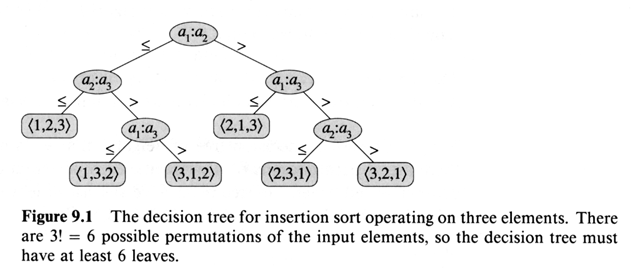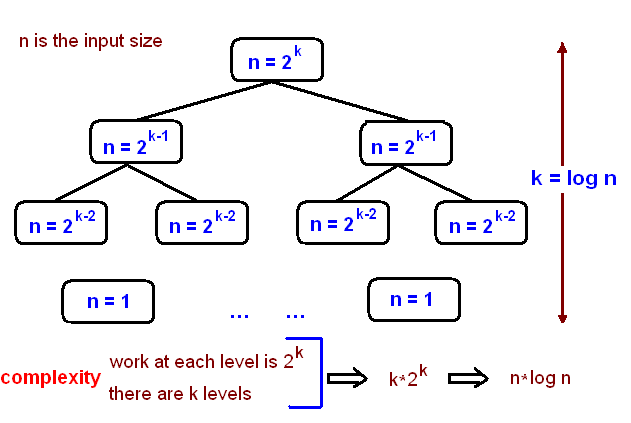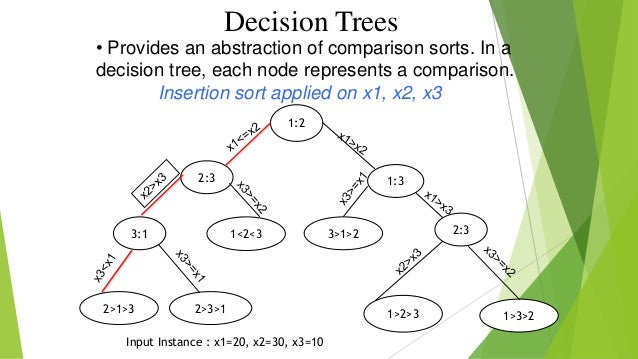Find Out 39+ Facts On Merge Sort Decision Tree People Missed to Let You in!
Merge Sort Decision Tree | I want to use it to make some tableaux for first order logic, which means i'll need to. E.g., insertion sort, merge sort, quicksort, heapsort. Hi, i really like the look of this tree and the simple commands. => read through the popular c++ training series here. Besides, decision trees are fundamental components of random forests.
Merge sort keeps on dividing the list into equal halves until it can no more be divided. Build a merge sort tree takes o(nlogn) time which is same as merge sort algorithm. Not the answer you're looking for? In computational complexity the decision tree model is the model of computation in which an algorithm is considered to be basically a decision tree, i.e., a sequence of queries or tests that are done adaptively, so the outcome of the previous tests can influence the test is performed next. Introduction to merge sort tree | segment tree course.

These subproblems are then combined or merged together to form a unified solution. => read through the popular c++ training series here. They are very powerful algorithms, capable of fitting complex datasets. Build a merge sort tree takes o(nlogn) time which is same as merge sort algorithm. The height of this decision tree is a lower bound on the running time. „ it uses a comparator „ it has o(n log n) running. Procedure mergesort( var a as array ) if ( n == 1. • a decision tree is a binary tree such that: A range l to r can divided into at most log(n). A decision tree for mergesort when run on 2^k elements. Q the key to merge sort is merging two sorted lists into one, such that if you have two sorted lists x = (x1£x2£…£xm) and y= (y1£y2£…£yn), the decision tree (cont.) q execution of sorting algorithm corresponds to tracing a path from root to leaf. Also try practice problems to test & improve your skill level. E.g., insertion sort, merge sort, quicksort, heapsort.
A range l to r can divided into at most log(n). Hi, i really like the look of this tree and the simple commands. In every node of a segment tree stores how many numbers are let's consider merging, except for 'nothing to merge', every time we call merge, the total number of allocated segment tree nodes will decrease by. Introduction to merge sort tree | segment tree course. It will take o(nlogn) memory because each number ai will be present in at most logn vectors (height of the tree ).

Detailed tutorial on merge sort to improve your understanding of {{ track }}. I want to use it to make some tableaux for first order logic, which means i'll need to. I can create a decision tree for iterative algorithms without any problem, but since this algorithm is recursive, i am confused. They are very powerful algorithms, capable of fitting complex datasets. You can use merge sort trees. (do not try to l(first + last)/2] first last sort recursively by mergesort sort recursively by mergesort sorted sorted merge sorted figure 4.13 mergesort strategy thus, using. A range l to r can divided into at most log(n). Build a merge sort tree takes o(nlogn) time which is same as merge sort algorithm. A decision tree for mergesort when run on 2^k elements. The height of this decision tree is a lower bound on the running time. Given an array of n integers. Merge sort algorithm uses the divide and conquer strategy wherein we divide the problem into subproblems and solve those subproblems individually. Decision trees are versatile machine learning algorithm that can perform both classification and regression tasks.
Mechanisms such as pruning, setting the minimum number of samples required at a leaf node or setting the maximum depth of the tree are necessary to avoid this problem. Build a merge sort tree takes o(nlogn) time which is same as merge sort algorithm. It will take o(nlogn) memory because each number ai will be present in at most logn vectors (height of the tree ). Now what is a merge sort tree? › each node = a set of orderings • ie, the remaining solution space › each edge = 1 comparison › each leaf = 1 unique ordering.

It starts at the top and proceeds downwards, with each recursive turn asking the same question such as what is required to be done to sort the array? and having the answer as, split the array into two, make a. • only 1 leaf has the ordering that is the desired correctly sorted arrangement. Detailed tutorial on merge sort to improve your understanding of {{ track }}. In computational complexity the decision tree model is the model of computation in which an algorithm is considered to be basically a decision tree, i.e., a sequence of queries or tests that are done adaptively, so the outcome of the previous tests can influence the test is performed next. › each node = a set of orderings • ie, the remaining solution space › each edge = 1 comparison › each leaf = 1 unique ordering. It will take o(nlogn) memory because each number ai will be present in at most logn vectors (height of the tree ). (s1, s2) ← partition(s, n/2) mergesort(s1, c) mergesort(s2, c) s ← merge(s1, s2). Q the tree models all possible execution traces. In this sorting algorithm we use the idea of divide and conquer. I want to use it to make some tableaux for first order logic, which means i'll need to. Merge sort algorithm follows divide and conquer strategy to quickly sort any given array. They are very powerful algorithms, capable of fitting complex datasets. Q the key to merge sort is merging two sorted lists into one, such that if you have two sorted lists x = (x1£x2£…£xm) and y= (y1£y2£…£yn), the decision tree (cont.) q execution of sorting algorithm corresponds to tracing a path from root to leaf.
Merge Sort Decision Tree: › each node = a set of orderings • ie, the remaining solution space › each edge = 1 comparison › each leaf = 1 unique ordering.
Source: Merge Sort Decision Tree
0 Response to "Find Out 39+ Facts On Merge Sort Decision Tree People Missed to Let You in!"
Post a Comment